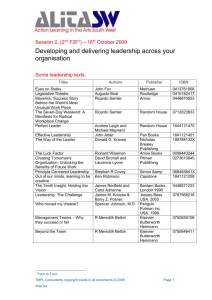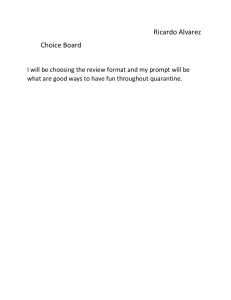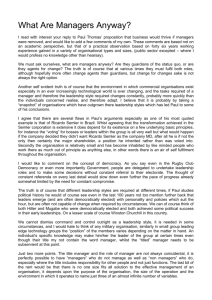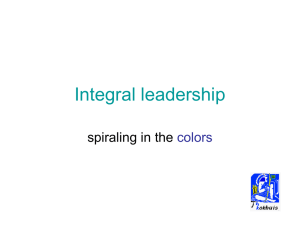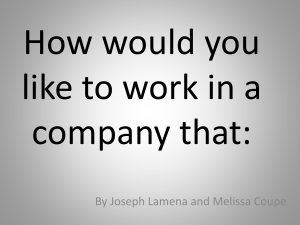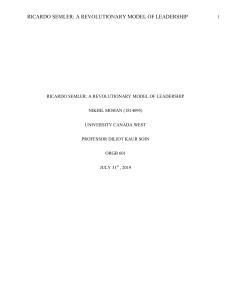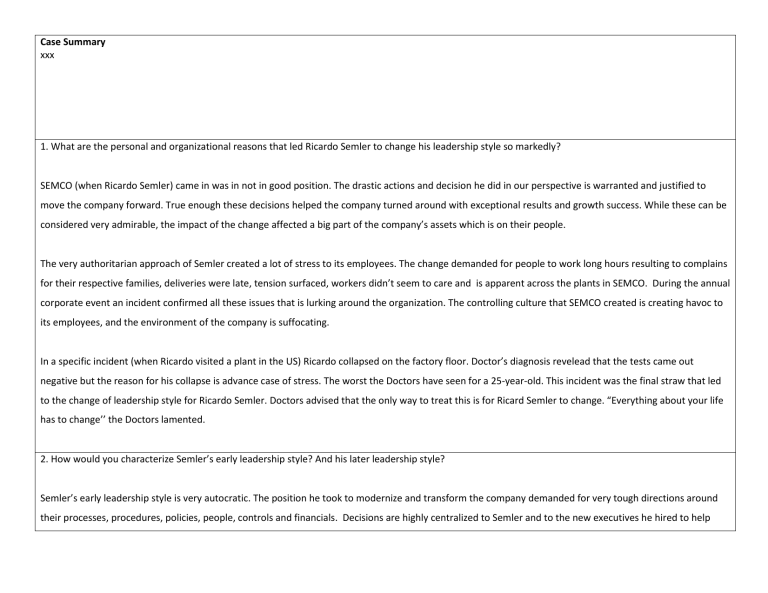
Case Summary xxx 1. What are the personal and organizational reasons that led Ricardo Semler to change his leadership style so markedly? SEMCO (when Ricardo Semler) came in was in not in good position. The drastic actions and decision he did in our perspective is warranted and justified to move the company forward. True enough these decisions helped the company turned around with exceptional results and growth success. While these can be considered very admirable, the impact of the change affected a big part of the company’s assets which is on their people. The very authoritarian approach of Semler created a lot of stress to its employees. The change demanded for people to work long hours resulting to complains for their respective families, deliveries were late, tension surfaced, workers didn’t seem to care and is apparent across the plants in SEMCO. During the annual corporate event an incident confirmed all these issues that is lurking around the organization. The controlling culture that SEMCO created is creating havoc to its employees, and the environment of the company is suffocating. In a specific incident (when Ricardo visited a plant in the US) Ricardo collapsed on the factory floor. Doctor’s diagnosis revelead that the tests came out negative but the reason for his collapse is advance case of stress. The worst the Doctors have seen for a 25-year-old. This incident was the final straw that led to the change of leadership style for Ricardo Semler. Doctors advised that the only way to treat this is for Ricard Semler to change. “Everything about your life has to change’’ the Doctors lamented. 2. How would you characterize Semler’s early leadership style? And his later leadership style? Semler’s early leadership style is very autocratic. The position he took to modernize and transform the company demanded for very tough directions around their processes, procedures, policies, people, controls and financials. Decisions are highly centralized to Semler and to the new executives he hired to help move the company forward. They become very tough minded, statistical, with little or no regard to what the employees will say or feel about their actions. A leadership style very much focused on driving the end results whatever it takes. 1984 was very meaningful for SEMCO. This was the time when Semler radically shifted his leadership style from being an autocratic to a democratic one. His style of leadership during this time was circled around empowering their employees to manage themselves and drive decisions. Semler and his leadership team has given up control and advocated trust, transparency of information to its people. Ricardo together with his new HR Director worked on several initiatives to support this change. Early interventions in policies were around beginning-and-end-of-shift surveillance, dress code, car park policies, expense reports, and an open office plan. Middle managers however find this to be a concern. They felt they don’t have control anymore to their people. For this group, this touchy-feely approach is nonsense. For Ricardo however, leadership is not about the titles but it’s about the peoples knowledge and leadership qualities that they can exercise even if they are not the boss themselves. 3. Which Ricardo – early or late – would you rather have as your boss? Why? Which Ricardo would you rather have as a subordinate? In our perspective, leadership style should be flexible depending on the situation that warrants the call for action. However, if we were to have a boss and chose the leadership style, he/she adopts, we will chose the late Ricardo which adopts a democratic leadership style. While it is not a perfect style that would apply to all organizations, the values embedded in the democratic style leadership is very empowering. It advocates trust, very inspirational and flexible. Given that not only employees are empowered, leaders and managers can work and partner with them. This could also mean bosses and employees can be both part of the solution and the decision-making process. If on the other hand we would have a sub ordinate, we will also chose the late Ricardo. In a similar perspective, as a leader we also would like our teams to be very much involved both in the solution and the decision making process. A subordinate who is engaged and empowered to do what is right for the business and organization will translate to better commitment from the employee and outcomes for the business. A culture that is centered on trust, mutual respect and transparency is beneficial both for the organization and the employees. 4. To what extent do you think Ricardo would succeed as a leader in other types of organizations? The biggest challenge in every organization is setting up the right culture where both employees interest and the goals of the business will thrive and co-exist. While the story of Ricardo and SEMCO is very remarkable, applying the same approach as a leader in other organization could be a challenge. This is because organizations differ in terms of culture, the priority, the objectives, and the people comprising them. SEMCO was a success, but it did not start in the same way how it is today. It has to undergo transformation, learn from the experience, introduce the changes, adopt, gather feedback, take action, adjust and then embrace the culture. A key ingredient will be how the people will receive it and how it closely aligns to their values and priorities. The SEMCO Philosophy is something that every leader and organization should aspire for but adopting it will take time for other organizations to embrace. A comprehensive diagnosis of the business and the culture of the organization is required before a plan is in place. Will this be enough to be successful, again it will depend. As we reflect on the case, the success does not rest with the leader itself but also with the people and how they work together. C - Communication H - Humility A - Adopt N - New Perspective G - Governance E - Engage
